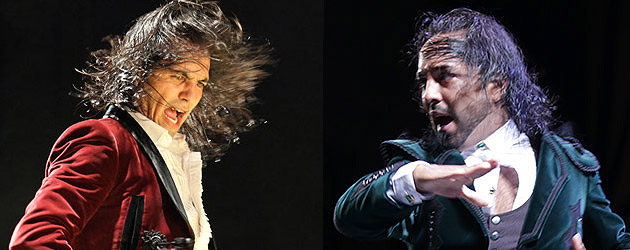Text: Silvia Cruz Lapeña
Photos: DeFlamenco.com
Festival de Flamencos y Otras Aves
Presentation of Barullo's Cara y Cruz
Farruquito & Faraona guest artists
Guitar: El Perla & Raúl Vicenti
Cajón: Piraña
Guest artists: Farruquito and La Faraona
Just call me Farruco
Shortly before the premiere performance of Cara y Cruz, the Christmas lights in the streets of Barcelona were turned on. But at the Sala Apolo there was another kind of decoration: the long line that formed to see three «Farrucos» for the price of one. Lots of young people, which was very heartening because this is not always the case at flamenco events, and it augures well for the future. The «Farrucos» always generate excitement, and this time there was interest in seeing Barullo's first show of his own after winning the Desplante dance prize last summer at the Festival del Cante de las Minas de La Unión.
Things got underway a half-hour late, and with unnecessary preparation: off-stage voices of the dancer and his mother La Faraona, explaining who Barullo is. And that prologue, aside from being poorly prepared, was unnecessary. Because as soon as Barullo began to dance, it was like a good novel that draws from other sources but is self-explanatory.
Barullo began seated and bare-chested, but tied a shirt to the level of his midriff. He got directly into bulerías, and it wouldn't have been necessary to know his name, each eloquent gesture seemed to take pleasure in saying: «Just call me Farruco». Except for obvious differences of age and corpulence, legs and hips, it was all his grandfather. Even Barullo's hat, even the cane.
«Cara y Cruz», heads and tails was he title of the show, expressing the intent to deal with tradition and avant-garde, or at least that's what it said in the program. Because you have the feeling Barullo wants to take bigger risks than he's taking now. You can tell from his ways and in several original moves, such as in the siguiriyas. He began the dance with control and precision, doling out the flourishes the audience most applauds, as if wanting to protect the family's brand-name, while at the same time showing his individuality. Because just when you think it's business as usual, he pulls off his shirt and throws it in the air as if tossing a coin to decide his fate while showing his form wearing leggings and a T-shirt to appear half classic dancer and half flamenco dancer. In shiny black, he skillfully marked each heel and toe, although not on the floor but in the air, as if indicating other horizons to which he aspires. And not a single iffy moment, everything was straight from the roots, and he was flamenco even standing still.
Still dressed in this way, he sat down to rest, and from the rear of the stage appeared his cousin. Farruquito was the perfect announcement of the family line, dressed in white for alegrías and showing another face of the same coin. Juan floated across the stage showing off his artistic maturity and giving a lesson to young people demonstrating that he can only be the best. And in front of an audience, no one is better than him. He shined brightly because that is his destiny, although he did not want to steal the show from Barullo who looked on and cheered each of his cousin's steps like an adoring fan.
Barullo danced tangos and bulerías, made good on the siguiriya that nearly cost him the prize in La Unión and which came together here in Barcelona, a city which received him as a full-fledged star. Barullo is 24, and still has a few things to learn and others to discover. In this his debut he danced well, very well, although Cara y Cruz needs a more coherent artistic direction, a better choice of verses and at times you had the feeling there was more singing than dancing although frankly, it's always a pleasure to listen to Miguel de la Tolea.
Special mention for El Perla on guitar. This man ought to have a bigger say. He's got the crisp sound that gets you out of your seat. He knows it and so does the audience, which is why you want to see him do more than he does.
At the end of the show, La Faraona came out to prove that the entire history of flamenco can be expressed in a single simple roll of the shoulder. Farruquito again, with whom Barullo marked a bulerías flourish that drove fans crazy. Then, the son and the nephew backed up the daughter of Farruco to wrap up the show with a very flamenco festive epilogue which required no explanation whatsoever.
